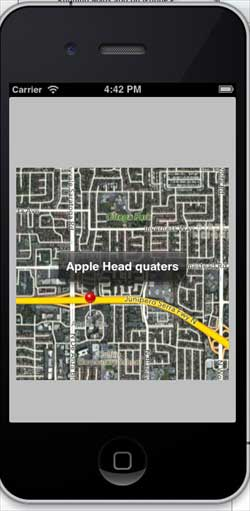iOS map development
May 21, 2021 iOS Development Manual
Table of contents
IOS map development
Brief introduction
IOS maps help us locate locations, and IOS maps use the MapKit framework.
The instance step
1. Create a simple View base application
2. Select the project file, then select the target, and then add MapKit.framework.
3. Add Corelocation.framework
4. Add a map view to ViewController.xib and create ibOutlet and name mapView.
5. Create a new file by selecting Objective C class with "File-New -gt; File...", click Next
6. "sub class of of" is NSObject, a class named MapAnnotation
7. Choose to create
8. Update MapAnnotation.h, as shown below
#import <Foundation/Foundation.h> #import <MapKit/MapKit.h> @interface MapAnnotation : NSObject<MKAnnotation> @property (nonatomic, strong) NSString *title; @property (nonatomic, readwrite) CLLocationCoordinate2D coordinate; - (id)initWithTitle:(NSString *)title andCoordinate: (CLLocationCoordinate2D)coordinate2d; @end
9. Update the MapAnnotation .m, as shown below
#import "MapAnnotation.h"
@implementation MapAnnotation
-(id)initWithTitle:(NSString *)title andCoordinate:
(CLLocationCoordinate2D)coordinate2d{
self.title = title;
self.coordinate =coordinate2d;
return self;
}
@end
10. Update ViewController.h, as shown below
#import <UIKit/UIKit.h>
#import <MapKit/MapKit.h>
#import <CoreLocation/CoreLocation.h>
@interface ViewController : UIViewController<MKMapViewDelegate>
{
MKMapView *mapView;
}
@end
11. Update the ViewController .m, as shown below
#import "ViewController.h"
#import "MapAnnotation.h"
@interface ViewController ()
@end
@implementation ViewController
- (void)viewDidLoad
{
[super viewDidLoad];
mapView = [[MKMapView alloc]initWithFrame:
CGRectMake(10, 100, 300, 300)];
mapView.delegate = self;
mapView.centerCoordinate = CLLocationCoordinate2DMake(37.32, -122.03);
mapView.mapType = MKMapTypeHybrid;
CLLocationCoordinate2D location;
location.latitude = (double) 37.332768;
location.longitude = (double) -122.030039;
// Add the annotation to our map view
MapAnnotation *newAnnotation = [[MapAnnotation alloc]
initWithTitle:@"Apple Head quaters" andCoordinate:location];
[mapView addAnnotation:newAnnotation];
CLLocationCoordinate2D location2;
location2.latitude = (double) 37.35239;
location2.longitude = (double) -122.025919;
MapAnnotation *newAnnotation2 = [[MapAnnotation alloc]
initWithTitle:@"Test annotation" andCoordinate:location2];
[mapView addAnnotation:newAnnotation2];
[self.view addSubview:mapView];
}
// When a map annotation point is added, zoom to it (1500 range)
- (void)mapView:(MKMapView *)mv didAddAnnotationViews:(NSArray *)views
{
MKAnnotationView *annotationView = [views objectAtIndex:0];
id <MKAnnotation> mp = [annotationView annotation];
MKCoordinateRegion region = MKCoordinateRegionMakeWithDistance
([mp coordinate], 1500, 1500);
[mv setRegion:region animated:YES];
[mv selectAnnotation:mp animated:YES];
}
- (void)didReceiveMemoryWarning
{
[super didReceiveMemoryWarning];
// Dispose of any resources that can be recreated.
}
@end
Output
When you run the application, the output is as follows

When we scroll up the map, the output is as follows
